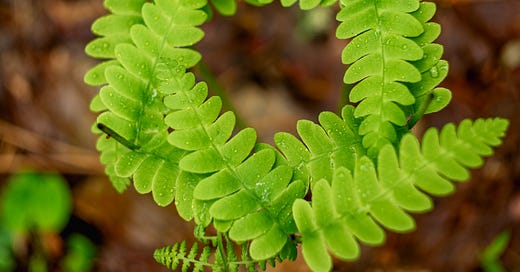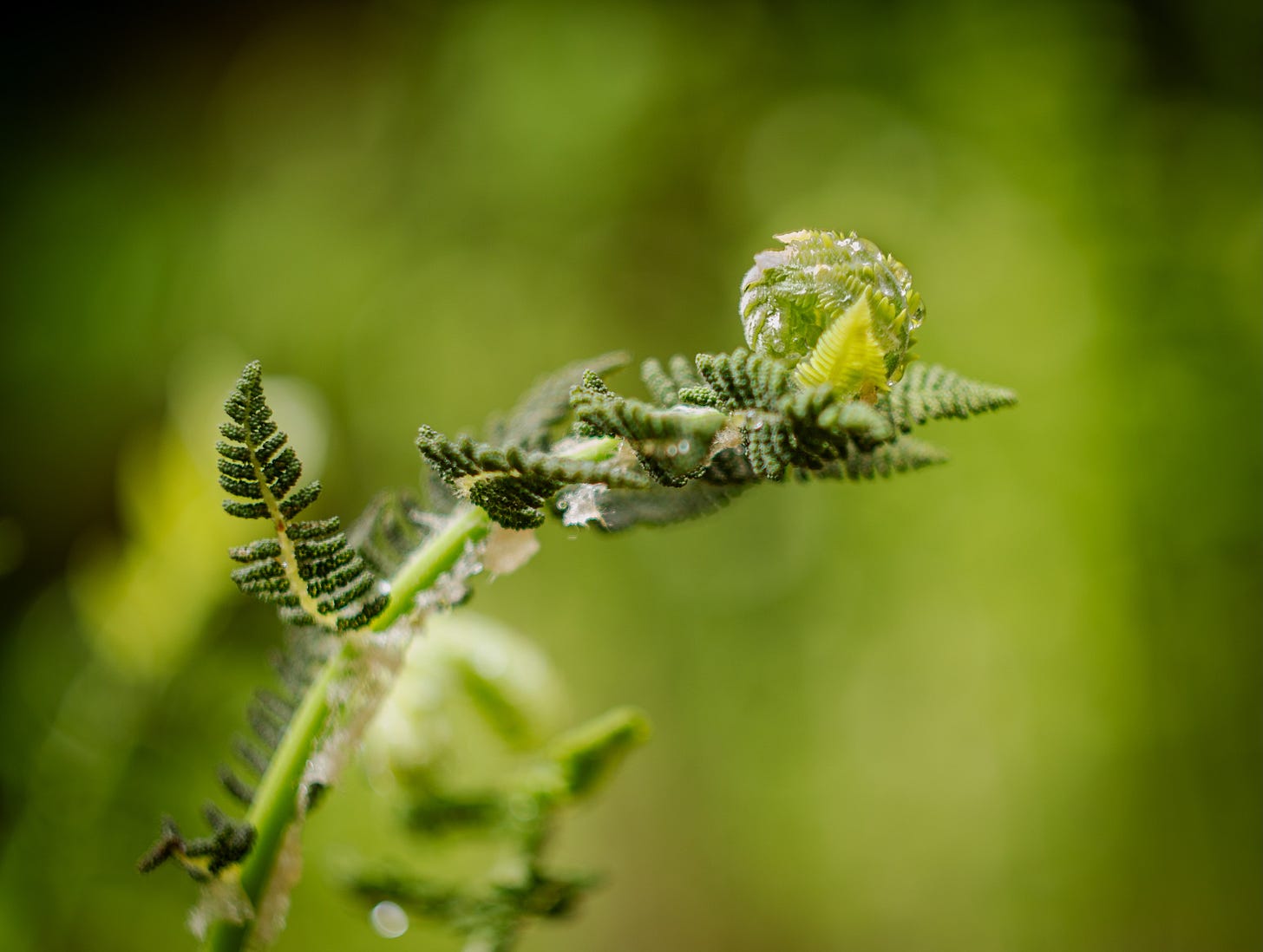More than Just a "Little Green"
A reflection on the sudden awakening of the Adirondack forest.
I’m here at our cabin, alone this Memorial Day weekend continuing to tend to things as we prepare for another summer—cutting into firewood rounds the top of the big yellow birch that came down in a winter storm, falling dangerously close to the solar panel array and the cabin itself, putting in my “boathouse,” 1 1/2 inch PVC pipe glued to make a frame, a thick canvas tarp draped over it and zip-tied in place. It was made by the previous owner to house his lovely Adirondack guide boat. Now it houses my sunfish sailboat and requires additional layers of duct tape each year to help hold together its easy-to-crack, aging PVC. I’ve also duct taped the mouth of our rainbow fish windsock that spins at the tip of an old fishing rod held fast to the dock with still more zip ties. Zip ties, duct tape my go-to “tools” this weekend. I’ve even replaced a large tear in the fold-up, screen “bug house,” which is just big enough for two plastic Adirondack chairs, at the lake-side deck. The black flies make it a necessity at this time of year, and I’m sitting here now listening to the tap tap of waves against the sunfish hull beneath the dark green tarp of the boathouse, gusts of wind coming and going in the tree tops, gusts I was sailing in not long ago, trying my best to navigate with post-storm-winds blowing from every compass direction, sometimes all-at-once, two walls of wind from opposite ends of the lake converging on my sail periodically leaving me unmoving, sails flapping mid-lake. I also hear assorted chortling songbirds, occasional loon-song.
But perhaps the most striking thing I’ve perceived these past three, mostly wet, low to mid 40s F. days is that everything, everywhere I look is green.
Where just a few weeks ago—when I was here last, opening up for the season with my daughter—the lake shore was only the dark greens of conifers and the browns and tans of the not-budding-even limbs of deciduous trees—cherry and birch, maple, American beech…. Now the shoreline—green green green—looks tender and new and alive.
Walking in the woods, green saturates the forest, so the long views up into the tangle of trunks and limbs has become a thousand shades of green.
Green erupts everywhere, each branch a spectacle of light lime leaves, kiwi-new, not yet full-sized. From the forest floor, another display: woodfern and trillium, their flowers faded and frail, Jack in the pulpit, starflower, bunchberry, wood sorrel, lady slippers, trout lily, wild sarsaparilla….
The newly sprouted ferns unfurl into spectrums of green, from dark-almost-black to pale-nearly-yellow.
I bring along my camera, an older, humble Lumix I have recently outfitted with a cheap, Soviet-era, “Helix 44-2,” manual focus lens. With a wide open aperture, the out of focus background (or “bokeh”) is a striking, circular, creamy blur caused somehow by the unique way Soviet optics techs pieced glass layers together back in the 1950s. Whatever it is that gives this effect, it seems perfect for the dizzying extravaganza of greenery I feel as if I am swimming through.
I close the aperture all the way down, set the ISO as low as possible, and start experimenting with different slow shutter speeds, flicks, twists, swirls, smooth and jerky camera motions made as I press the shutter release.
I’ve become a fan and sometime practitioner of Intentional Camera Motion (ICM) photography, and as I “develop” shots later on my computer, I’m amazed at how several of these—along with the best “bokeh” shots—give voice to this immersion in green.

In this miracle of the alive-again forest, I, too, feel revitalized, reawakened amidst so much green—“the color when the spring is born” (Joni Mitchell, “A Little Green).
If you’ve been enjoying my writing, please consider doing any/all of the following:
Help me grow my audience by Sharing this post or my main site with a few people you think might enjoy it as well.
Upgrade your subscription to paid. For only $.14/day, you can help me continue to devote the many hours I do each week to writing, editing and promoting this page.
JourneyCasts is a reader-supported publication. To receive new posts and support my work, consider becoming a free or paid subscriber.
JourneyCasts is a reader-supported publication. To receive new posts and support my work, consider becoming a free or paid subscriber.
You can also help a lot by making a one-time contribution at any time by “buying me a coffee” (or two). And certainly a good amount of real coffee has gone into the making of JourneyCasts.
As always, I encourage you to leave a comment.
Be sure to check out my podcast, “Hemingway, Word for Word.”







Your words roll off onto my thoughts with enjoyable ease and I too had a Sunfish.